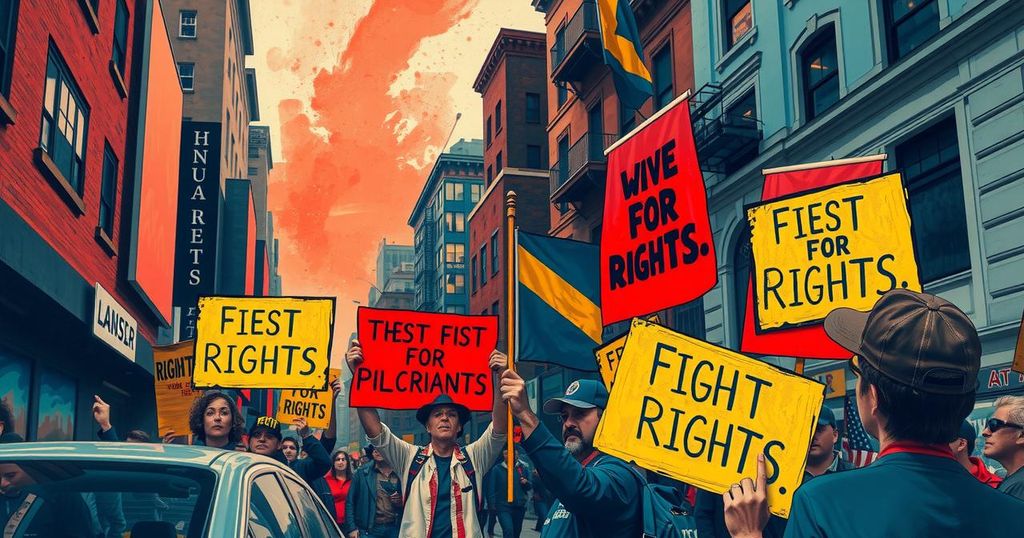Iran Protests Continue Amid Economic Hardship and Human Rights Abuses

On June 9, 2025, protests in Iran from various social groups highlight discontent with governmental policies. Exhibitions in Europe are drawing attention to human rights abuses, while three Iranians accused of espionage prepare for trial in 2026. Increasing crime rates signify broader issues of public insecurity linked to ineffective governance.
Fast Summary
On June 9, 2025, Iran continues to face widespread protests as citizens express their discontent with the regime’s failing policies. In recent weeks, retirees, workers, and boat owners have rallied against economic hardships and governmental corruption. Moreover, exhibitions across Europe have spotlighted human rights abuses in Iran. In legal news, three Iranians accused of spying for Tehran are set for trial in the UK in 2026. Meanwhile, incidents of rising crime reflect a disturbing trend of public insecurity encouraged by government inefficiency.
Article Body
In the past few weeks, cities across Iran have witnessed renewed protests from various social groups, including retirees, workers, and boat owners. These demonstrators have taken to the streets to voice their frustration against the current regime, attributing their anger to widespread corruption and mounting economic difficulties. The persistence of these protests underscores the determination of the Iranian people to claim their rights, despite increasing repression from the authorities.
Interestingly, on June 6, in Zahedan, local Resistance Units bravely carried out actions against the oppressive regime. This occurred amidst severe repression, as the regime clamors to maintain control through daily executions and a heightened security presence, especially targeting the Baluch community. The actions taken by these Resistance Units aim to dismantle the prevailing atmosphere of fear that surrounds them.
Multiple exhibitions across Europe have sharply criticized the Iranian regime’s human rights violations. In Bucharest, Romania, an exhibition organized by supporters of the People’s Mojahedin Organization of Iran (PMOI/MEK) highlighted the escalating execution rates of political prisoners. Similarly, in Rostock, Germany, activists also demanded the release of political prisoners and called for international accountability for high-ranking officials in Iran.
Berlin also saw a significant exhibition where supporters drew attention to the regime’s abuses, particularly concerning death sentences on political prisoners. Furthermore, in Bern, Switzerland, another exhibition focused on calling for the release of those unjustly imprisoned.
In a significant legal development, three Iranian men—Mostafa Sepahvand, Farhad Javadi Manesh, and Shapur Ghaleh Alikhani Noori—are set to appear before the Old Bailey court in London, facing accusations of espionage for the Iranian government. Their trial is scheduled for October 2026, and preliminary statements from their defense suggest they will plead “not guilty.”
The situation in Iran displays a worrisome escalation of crime and public insecurity, marked by tragic incidents such as the murders of Amir Mohammad Khaleghi and Elaheh Hosseinnejad. These high-profile killings have raised fears about the broader implications of a crumbling social order, fueled by a combination of economic strife and governmental incompetence.
Compounding this chaos, experts have warned of a calculated strategy employed by the Iranian regime that progressively tightens its grip on civil liberties throughout the country. This approach involves testing authoritarian measures in select provinces before rolling them out to other regions, indicating a systematic plan for nationwide repression.
In another striking narrative, a resistance activist, known only as Fereshteh, conveyed alarming insights about the Iranian government’s potential use of nuclear weapons against its adversaries. Highlighting the regime’s descent into barbarism and its desperate reliance on brutality to control the populace, she revealed that she joined the resistance after her sister was executed. Fereshteh’s story is just one among many that illustrate the growing network of resistance units across Iran.
In summary, the protests in Iran amidst economic struggles and human rights abuses clearly reflect the citizens’ quest for change. Exhibitions abroad are underscoring these violations, while legal proceedings against alleged spies add layers to the narrative of repression. The disheartening increase in crime is indicative of deeper systemic issues, highlighting the interplay of governmental failure and civil unrest. It’s clear that the Iranian people are seeking transformation through both awareness and active resistance against their oppressors.
Original Source: www.ncr-iran.org






